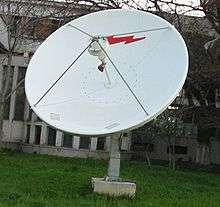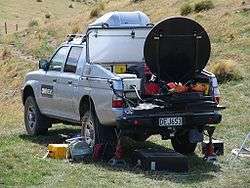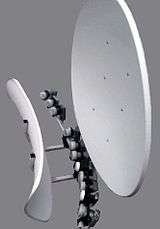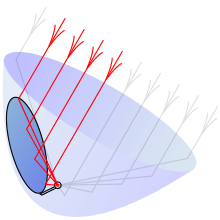Satellite dish


| Part of a series on |
| Antennas |
|---|
 |
|
Common types |
|
Radiation sources / regions |
A satellite dish is a dish-shaped type of parabolic antenna designed to receive electromagnetic signals from satellites, which transmit data transmissions or broadcasts, such as satellite television.
Principle of operation

The parabolic shape of a dish reflects the signal to the dish’s focal point. Mounted on brackets at the dish's focal point is a device called a feedhorn. This feedhorn is essentially the front-end of a waveguide that gathers the signals at or near the focal point and 'conducts' them to a low-noise block downconverter or LNB. The LNB converts the signals from electromagnetic or radio waves to electrical signals and shifts the signals from the downlinked C-band and/or Ku-band to the L-band range. Direct broadcast satellite dishes use an LNBF, which integrates the feedhorn with the LNB. (A new form of omnidirectional satellite antenna, which does not use a directed parabolic dish and can be used on a mobile platform such as a vehicle was announced by the University of Waterloo in 2004.[1]
The theoretical gain (directive gain) of a dish increases as the frequency increases. The actual gain depends on many factors including surface finish, accuracy of shape, feedhorn matching. A typical value for a consumer type 60 cm satellite dish at 11.75 GHz is 37.50 dB.
With lower frequencies, C-band for example, dish designers have a wider choice of materials. The large size of dish required for lower frequencies led to the dishes being constructed from metal mesh on a metal framework. At higher frequencies, mesh type designs are rarer though some designs have used a solid dish with perforations.
A common misconception is that the LNBF (low-noise block/feedhorn), the device at the front of the dish, receives the signal directly from the atmosphere. For instance, one BBC News downlink shows a "red signal" being received by the LNBF directly instead of being beamed to the dish, which because of its parabolic shape will collect the signal into a smaller area and deliver it to the LNBF.[2]
Modern dishes intended for home television use are generally 43 cm (18 in) to 80 cm (31 in) in diameter, and are fixed in one position, for Ku-band reception from one orbital position. Prior to the existence of direct broadcast satellite services, home users would generally have a motorised C-band dish of up to 3 m in diameter for reception of channels from different satellites. Overly small dishes can still cause problems, however, including rain fade and interference from adjacent satellites.
Europe
In Europe, the frequencies used by DBS services are 10.7–12.75 GHz on two polarisations H (Horizontal) and V (Vertical). This range is divided into a "low band" with 10.7–11.7 GHz, and a "high band" with 11.7–12.75 GHz. This results in two frequency bands, each with a bandwidth of about 1 GHz, each with two possible polarizations. In the LNB they become down converted to 950–2150 MHz, which is the frequency range allocated for the satellite service on the coaxial cable between LNBF and receiver. Lower frequencies are allocated to cable and terrestrial TV, FM radio, etc. Only one of these frequency bands fits on the coaxial cable, so each of these bands needs a separate cable from the LNBF to a switching matrix or the receiver needs to select one of the 4 possibilities at a time.
Systems design
In a single receiver residential installation there is a single coaxial cable running from the receiver set-top box in the building to the LNB on the dish. The DC electric power for the LNB is provided through the same coaxial cable conductors that carry the signal to the receiver. In addition, control signals are also transmitted from the receiver to the LNB through the cable. The receiver uses different power supply voltages (13 / 18 V) to select antenna polarization, and pilot tones (22 kHz) to instruct the LNB to select one of the two frequency bands. In larger installations each band and polarization is given its own cable, so there are 4 cables from the LNB to a switching matrix, which allows the connection of multiple receivers in a star topology using the same signalling method as in a single receiver installation.
A satellite finder may aid in aiming.
Types
Motor-driven dish
A dish that is mounted on a pole and driven by a stepper motor or a servo can be controlled and rotated to face any satellite position in the sky. Motor-driven dishes are popular with enthusiasts. There are three competing standards: DiSEqC, USALS, and 36 V positioners. Many receivers support all of these standards.
Multi-satellite

Some designs enable simultaneous reception from multiple different satellite positions without re-positioning the dish. The vertical axis operates as an off-axis concave parabolic concave hyperbolic Cassegrain reflector, while the horizontal axis operates as a concave convex Cassegrain. The spot from the main dish wanders across the secondary, which corrects astigmatism by its varying curvature. The elliptic aperture of the primary is designed to fit the deformed illumination by the horns. Due to double spill-over, this makes more sense for a large dish.
VSAT
A common type of dish is the very small aperture terminal (VSAT). This provides two way satellite internet communications for both consumers and private networks for organizations. Today most VSATs operate in Ku band; C band is restricted to less populated regions of the world. There is a move which started in 2005 towards new Ka band satellites operating at higher frequencies, offering greater performance at lower cost. These antennas vary from 74 to 120 cm (29 to 47 in) in most applications though C-band VSATs may be as large as 4 m (13 ft).
Others


- Individual dishes serving one dwelling: Direct to Home (DTH).
- Collective dishes, shared by several dwellings: satellite master antenna television (SMATV) or communal antenna broadcast distribution (CABD).
- Automatic Tracking Satellite Dish
- General Electric satellite dish for DirecTV satellite television.
- Satellite dishes installed on an apartment complex.
 The back side of an old C-band satellite dish showing the pole, mount, motor, and structure of the dish.
The back side of an old C-band satellite dish showing the pole, mount, motor, and structure of the dish.- WWE HD trucks in a parking lot.
 Satellite dish at a hut in East Timor
Satellite dish at a hut in East Timor
Ad hoc
The dish is a reflector antenna and almost anything that reflects radio frequencies can be used as a reflector antenna. This has led to trash can lids, woks, and other items being used as "dishes". Coupled with low noise LNBs and the higher transmission power of DTH satellites, it is easier to get a usable signal on some of these "dishes".
History
Parabolic antennas referred to as "dish" antennas had been in use long before satellite television. The term "satellite dish" was coined in 1978 during the beginning of the satellite television industry, and came to refer to dish antennas that send and/or receive signals from communications satellites. Taylor Howard of San Andreas, California adapted an ex-military dish in 1976 and became the first person to receive satellite television signals using it.[3]
The first satellite television dishes were built to receive signals on the C-band analog, and were very large. The front cover of the 1979 Neiman-Marcus Christmas catalog featured the first home satellite TV stations on sale.[4] The dishes were nearly 20 feet (6.1 m) in diameter.[5] The satellite dishes of the early 1980s were 10 to 16 feet (3.0 to 4.9 m) in diameter[6] and made of fiberglass with an embedded layer of wire mesh or aluminum foil, or solid aluminum or steel.[7]
Satellite dishes made of wire mesh first came out in the early 1980s, and were at first 10 feet (3.0 m) in diameter. As the front-end technology improved and the noise figure of the LNBs fell, the size shrank to 8 feet (2.4 m) a few years later, and continued to get smaller reducing to 6 feet (1.8 m) feet by the late 1980s and 4 feet (1.2 m) by the early 1990s.[8] Larger dishes continued to be used, however.[8] In December 1988 Luxembourg's Astra 1A satellite began transmitting analog television signals on the Ku band for the European market.[9] This allowed small dishes (90 cm) to be used reliably for the first time.[9]
In the early 1990s, four large American cable companies founded PrimeStar, a direct broadcasting company using medium power satellites.[10] The relatively strong Ku band transmissions allowed the use of dishes as small as 90 cm for the first time.[10] On 4 March 1996 EchoStar introduced Digital Sky Highway (Dish Network).[11] This was the first widely used direct-broadcast satellite television system and allowed dishes as small as 20 cm to be used. This great decrease of dish size also allowed satellite dishes to be installed on vehicles.[12] Dishes this size are still in use today. Television stations, however, still prefer to transmit their signals on the C-band analog with large dishes due to the fact that C-band signals are less prone to rain fade than Ku band signals.[13]
See also
References
- ↑ "Team develops in-car satellite TV". University of Waterloo. 2006-05-06. Retrieved 2008-04-29.
- ↑ "News 24 STILL gets an F for physics". Retrieved 2008-04-29.
- ↑ Feder, Barnaby J. (15 November 2002). "Taylor Howard, 70, Pioneer In Satellite TV for the Home". New York Times. Retrieved 19 July 2014.
- ↑ Browne, Ray (2001). The Guide to United States Popular Culture. Madison, Wisconsin: Popular Press. p. 706. ISBN 9780879728212. Retrieved 1 July 2014.
- ↑ Giarrusso, Michael (28 July 1996). "Tiny Satellite Dishes Sprout in Rural Areas". Los Angeles Times. Los Angeles: Los Angeles Times. Retrieved 1 July 2014.
- ↑ Nye, Doug (14 January 1990). "SATELLITE DISHES SURVIVE GREAT SCRAMBLE OF 1980S". Deseret News. Salt Lake City: Deseret News. Retrieved 30 June 2014.
- ↑ Brooks, Andree (10 October 1993). "Old satellite dish restrictions under fire New laws urged for smaller models". The Baltimore Sun. Baltimore, MD: The Baltimore Sun. Retrieved 1 July 2014.
- 1 2 Somerfield, Harry (30 September 1990). "Satellite dishes getting smaller, sharper in future". The Tuscaloosa News. Tuscaloosa, Alabama. Retrieved 7 August 2014.
- 1 2 "ASTRA 1A Satellite details 1988-109B NORAD 19688". N2YO. 9 July 2014. Retrieved 12 July 2014.
- 1 2 Barber, Dave (18 August 1995). "500,000 families already made PRIMESTAR their choice in satellite TV". Bangor Daily News. Bangor, Maine. Retrieved 7 August 2014.
- ↑ Grant, August E. Communication Technology Update (10th ed.). Taylor & Francis. p. 87. ISBN 978-0-240-81475-9.
- ↑ Evangelista, Benny (10 November 2003). "Satellite TV in the car, on the move / New technology makes dish receivers small enough to fit atop an SUV". San Francisco Chronicle. San Francisco. Retrieved 7 August 2014.
- ↑ "Rain fade: satellite TV signal and adverse weather". Dish-cable.com. Dish-cable.com. 2010. Retrieved 16 July 2014.
External links
| Wikimedia Commons has media related to Satellite dishes (residential). |
- European Commission: The right to use a satellite dish.
- DishPointer – Satellite dish alignment with Google Maps.
- Guide explaining how to self install freesat
- Online Satellite Finder Based on Google Maps